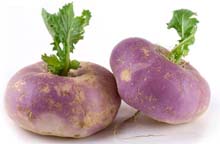Turnips Nutrition Facts
Turnips belong to the genus cruciferae and were everyday staples before potatoes were abundant. They are usually white in color from the bottom till halfway and become light purple, red or green according to the sunlight that has fallen on them, till the top. The leaves of the turnip are also edible and are eaten as turnip greens.
Turnips are high only in vitamin C. Turnip greens, on the other hand, are an excellent source of vitamin A (through their concentration of carotenoids such as beta-carotene), and especially large amount of lutein, which has been shown to help prevent cataracts and cardiovascular disease. They are also an excellent source of vitamin C, vitamin E, vitamin B6, folate, copper, calcium, and dietary fiber.

Three examples of conditions for which turnip greens may be of special importance are rheumatoid arthritis, colorectal cancer and atherosclerosis, according to the website Whfoods.org:
"The beta-carotene in turnip greens is important because low levels of vitamin A, which can be formed in the body from beta-carotene, are associated with rheumatoid arthritis. Vitamin A supports the proper function of the immune system as well as helps the body to produce and maintain healthy membranes, including the synovial membrane that lines our joints. The vitamin C and vitamin E provided by turnip greens work in concert to quench free radicals that can otherwise exacerbate joint damage. Since rheumatoid arthritis can cause bone loss-thus increasing the risk of osteoporosis-the calcium provided by turnip greens is also of special benefit. And, as an excellent source of the mineral copper, turnip greens may again help those with rheumatoid arthritis since copper is necessary for the production of connective tissue, which is damaged in this autoimmune condition."
Very small turnips can be eaten raw, but larger ones, which can be tough, should be boiled for a few minutes. Turnips can also be cut into small cubes and steamed with other root vegetables. Try adding turnip cubes to soup or to a stir-fry. Turnip greens can be cooked like spinach. Although the greens can be eaten raw, you'll do better to cook them to prevent the bloating and gas that sometimes accompanies them. Try turnips during fall and winter, their peak seasons, for optimum taste and nutrition.
|